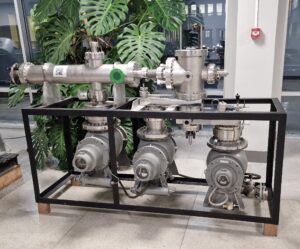Made in KBFI in 1992-1993.
In use as a MALDI-TOF mass spectrometer 1995-2005
In the reflector mode the device enabled a resolution of M/ΔM = 20,000

The device was built in the early nineties of the last century in cooperation with the Finnish CERN group to study the aging of the planned LHC gas detectors. At that time, it was planned to use gas detectors as detectors for the inner ring of the CMS, as the existing semiconductor detectors would not have been able to withstand the radiation load there. But then a way was found to make semiconductor detectors more radiation-resistant and cheaper, and the entire inner circle of LHC detectors switched to semiconductor detectors, which provide a significantly more accurate signal.
The device was never used for its original purpose, but in 1994, together with VTT, the idea came up to develop a MALDI mass spectrometer based on this machine, which was a novel and promising technique for the study of biomolecules at that time. There were very few commercial machines or they were worse than the ones built in the laboratory. In 1995, we obtained the first spectra, and with the addition of the reflectron, the instrument achieved a mass resolution of M/ΔM = 20000, which was the state-of-the-art at that time. The perspective of the MALDI method was so obvious that by 1997 there were already several very good commercial machines on the market, and apparatus construction in laboratories fell into the background.
However, the task of this apparatus was to bring MALDI to the arsenal of Estonian chemists and biochemists. Since the self-built apparatus was flexible, by changing detectors and excitation conditions, substances and processes could be studied that would be difficult or impossible to study in a commercial machine. . Since by 2005, high-resolution research had moved to commercial machines, while a smaller and more suitable apparatus had been built to study special processes, this spectrometer sank into oblivion.